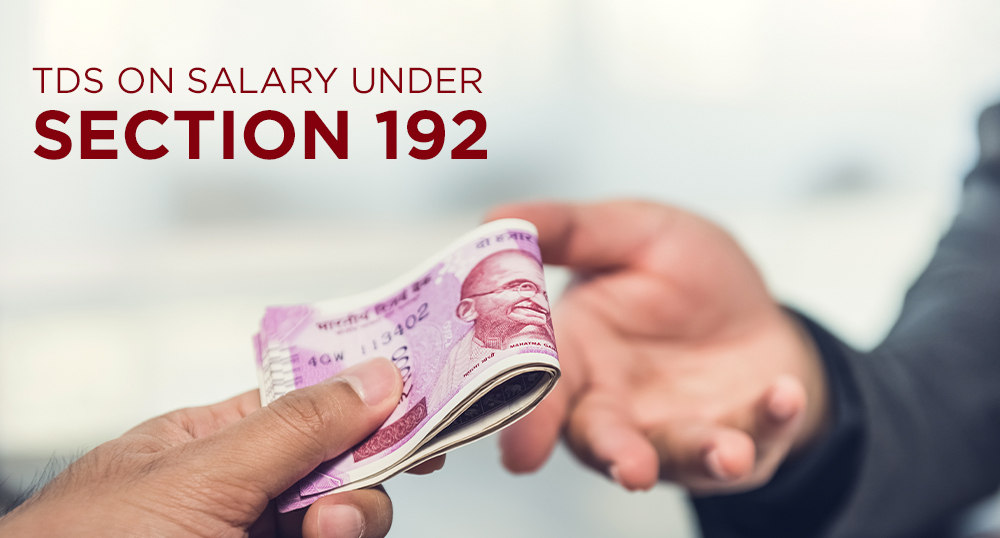TDS on Salary under Section 192
Introduction
Have you ever wondered why your take-home salary is often less than what you expected? This could be due to Tax Deducted at Source (TDS) on salary. Section 192 of the Income Tax Act, 1961 is a crucial aspect of the Indian taxation system that mandates every employer to deduct TDS on salary payments. It’s very important when it comes to TDS Returns. This article delves into the intricacies of TDS on salary, explaining who can deduct it, when it is applicable, and how to calculate it accurately.
Who can Deduct TDS under Section 192?
Section 192 affects a wide range of employers, such as::
- Individuals
- Hindu Undivided Families (HUFs)
- Firms
- Companies
- Trusts
- Associations of Persons (AOPs)
- Body of Individuals (BOIs)
- Local Authorities
- Every Artificial Judicial Person
Regardless of whether the employer is a government entity, private organization, or other form of legal entity, as long as there’s an employer-employee relationship, TDS deduction comes into play.
When is TDS Deducted under Section 192?
TDS under Section 192 is triggered when an employee’s taxable income exceeds the basic exemption limit. The basic exemption limits for different age groups are as follows:
- Below 60 years: Rs. 2,50,000/-
- 60 years or more but below 80 years: Rs. 3,00,000/-
- 80 years or above: Rs. 5,00,000/-
TDS is deducted at the time of actual payment of salary, whether it’s paid in advance, on time, or as arrears. Even in cases where an employee’s salary doesn’t surpass the basic exemption limit, if the employer pays advance salary or arrears, TDS applies.
Calculate TDS on Salary under Section 192
To accurately calculate TDS on salary under Section 192, follow these steps:
- Computation of Taxable Income: Estimate the employee’s salary for the financial year, including basic pay, allowances, bonuses, etc.
- Claim Exemptions: Deduct exemptions under Section 10 of the Income Tax Act, including HRA, travel expenses, etc.
- Reduce Deductions: Subtract deductions under Chapter VI-A, including investments, from the taxable salary.
- Adjust Other Income: If the employee has other income sources like rental income, add or subtract them to the net taxable salary.
- Consider Investments: Adjust investments declared by the employee, like PPF, EPF, life insurance premiums, etc.
- Calculate Tax: Calculate the applicable tax as per the tax slab rates and deductions.
- Divide Tax by Employment Months: Divide the estimated tax liability by the number of months in the employment period.
This calculated amount becomes the monthly TDS to be deducted by the employer.
Rate of TDS Deduction
The TDS rate under Section 192 isn’t fixed; it depends on the individual’s tax slab rate. The employer calculates TDS based on the estimated tax liability for the year, dividing it by the months of employment. In case an employee doesn’t provide a PAN, TDS is deducted at 20% plus a 4% cess.
Deductions under Section 89
Section 89 offers relief for employees who receive arrears or a higher rate of tax due to change in slab rates. Employers deduct TDS while considering this relief if you file Form 10E on the official income tax portal.
Conclusion
Understanding TDS on salary under Section 192 is crucial for both employers and employees. Employers must ensure accurate deduction, timely deposit, and proper documentation, while employees should be aware of how it impacts their take-home pay and how to claim deductions. By comprehending these intricacies, both parties can navigate the taxation landscape smoothly.
Frequently Asked Questions
What is TDS on salary under Section 192?
TDS on salary refers to the tax deducted by employers from an employee’s salary before disbursing it. Section 192 of the Income Tax Act mandates this deduction.
Who can deduct TDS under Section 192?
Employers of various types, including individuals, firms, companies, trusts, and more, are required to deduct TDS from employee salaries if an employer-employee relationship exists.
When is TDS on salary deducted under Section 192?
TDS is deducted when an employee’s taxable income exceeds the basic exemption limit. This applies when salary is paid in advance, on time, or as arrears.
How is TDS calculated on salary under Section 192?
TDS is calculated by estimating the employee’s annual salary, factoring in exemptions, deductions, and other income. The estimated tax liability is divided by the number of months in the employment period.
What is the rate of TDS deduction under Section 192?
The TDS rate depends on an individual’s tax slab rate. It’s calculated by dividing the estimated total tax liability by the employment period in months.
Can TDS be deducted if an employee doesn't have a PAN?
Yes, TDS can still be deducted, but at a rate of 20% plus a 4% cess.

Monjima Ghosh
Monjima is a lawyer and a professional content writer at LegalWiz.in. She has a keen interest in Legal technology & Legal design, and believes that content makes the world go round.







